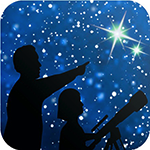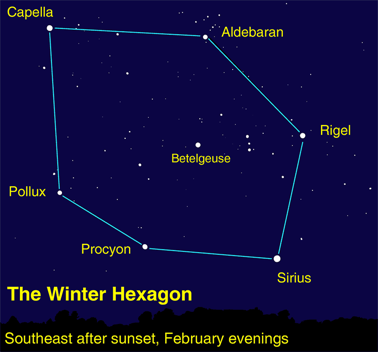
By David Prosper
NASA JPL
The stars that make up the Winter Hexagon asterism are some of the brightest in the night sky and February evenings are a great time to enjoy their sparkly splendor. The Winter Hexagon is so large in size that the six stars that make up its points are also the brightest members of six different constellations, making the Hexagon a great starting point for learning the winter sky. Find the Hexagon by looking southeast after sunset and finding the bright red star that forms the “left shoulder” of the constellation Orion: Betelgeuse. You can think of Betelgeuse as the center of a large irregular clock, with the Winter Hexagon stars as the clock’s hour numbers. Move diagonally across Orion to spot its “right foot,” the bright star Rigel. Now move clockwise from Rigel to the brightest star in the night sky: Sirius in Canis Major. Continue ticking along clockwise to Procyon in Canis Minor and then towards Pollux, the brighter of the Gemini twins. Keep moving around the circuit to find Capella in Auriga, and finish at orange Aldebaran, the “eye” of the V-shaped face of Taurus the Bull.
Two naked-eye planets are visible in the evening sky this month. As red Mars moves across Pisces, NASA’s InSight Mission is readying its suite of geological instruments designed to study the Martian interior. InSight and the rest of humanity’s robotic Martian emissaries will soon be joined by the Mars 2020 rover. The SUV-sized robot is slated to launch next year on a mission to study the possibility of past life on the red planet. A conjunction between Mars and Uranus on February 13 will be a treat for telescopic observers. Mars will pass a little over a degree away from Uranus and larger magnifications will allow comparisons between the small red disc of dusty Mars with the smaller and much more distant blue-green disc of ice giant Uranus.
Speedy Mercury has a good showing this month and makes its highest appearance in the evening on February 27; spot it above the western horizon at sunset. An unobstructed western view and binoculars will greatly help in catching Mercury against the glow of evening twilight.
The morning planets put on quite a show in February. Look for the bright planets Venus, Jupiter, and Saturn above the eastern horizon all month, at times forming a neat lineup. A crescent Moon makes a stunning addition on the mornings of February 1-2, and again on the 28th. Watch over the course of the month as Venus travels from its position above Jupiter to below dimmer Saturn. Venus and Saturn will be in close conjunction on the 18th; see if you can fit both planets into the same telescopic field of view. A telescope reveals the brilliant thin crescent phase of Venus waxing into a wide gibbous phase as the planet passes around the other side of our Sun. The Night Sky Network has a simple activity that helps explain the nature of both Venus and Mercury’s phases at bit.ly/venusphases
You can catch up on all of NASA’s current and future missions at nasa.gov

The stars of the Winter Hexagon.Image created with help from StellariumI
This article is distributed by NASA Night Sky Network The Night Sky Network program supports astronomy clubs across the USA dedicated to astronomy outreach. Visit nightsky.jpl.nasa.org to find local clubs, events, and more!
